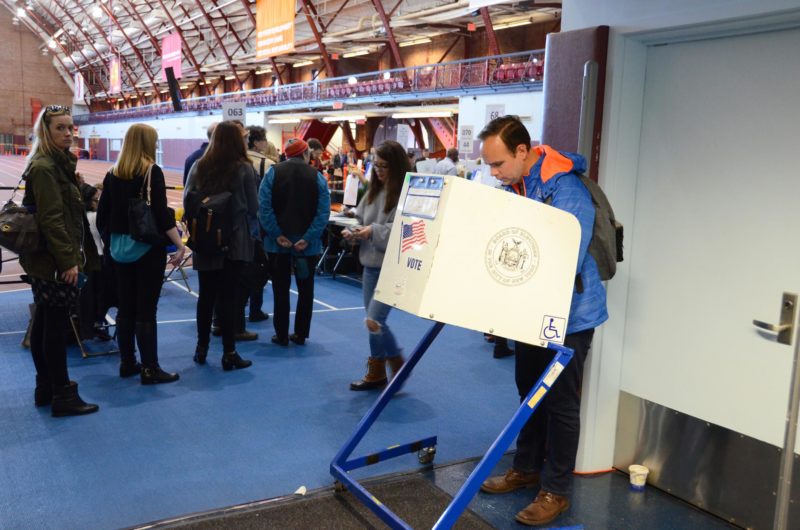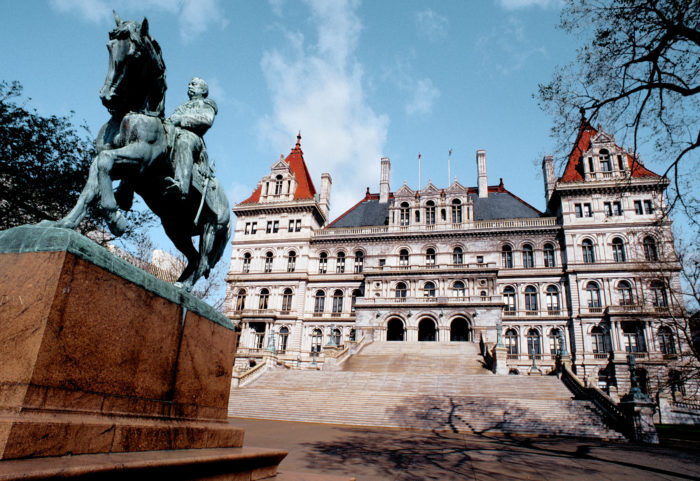Why New Yorkers Shouldn’t be Afraid of a Con-Con
If voters approve a Constitutional Convention, despite all the voices urging them to 'vote no,' this could be the start of fixing a broken system
Voters casting their ballots at the Park Slope Armory in last November's election (Photo by Simon Leigh/Camera Press/Redux)
In Martin Scorsese’s Casino, a group of mob bosses facing trial gather to figure out a hit list of potential witnesses. The discussion centers on their old ally, Andy Stone, the head of the Teamsters Pension Fund. Not one of the bosses at the table believes there is any realistic possibility that Stone will be turned as a government witness, but ultimately, the head man at the table, Remo Gaggi, settles the discussion by saying:
“Look … why take a chance?”
Decades ago, Kevin Phillips, a leading conservative intellectual, came up with the term “reactionary liberalism” to describe the tendency of many liberal interest groups and politicians to be more concerned about circling the wagons to ensure the preservation of the governmental status quo than they were in advancing actual progressive values.
It is perhaps best expressed as the triumph of “Change we can avoid” over “Change we can believe in.”
And this tendency has no more illustrative embodiment in today’s New York State than in the organized opposition to a Constitutional Convention, an opposition that includes virtually every public employee union and liberal interest group.
Every 20 years, the State Constitution requires a referendum on whether we are to have such a convention, where 204 elected delegates would have the opportunity to amend the founding document. Not since the 1930s has such a referendum passed. (There was a convention in the 1960s, initiated by the legislature in response to the peculiar circumstances of the times, but the electorate voted down its recommendations). In the election on Nov. 7, we get another chance to vote for a Con-Con, and one would think, with our dysfunctional state government, there’d be a loud clamor for such a gathering among those who call themselves “progressives.”
One would think wrong.

New York State’s capitol building in Albany, where delegates to a constitutional convention would gather in 2019 (Photo by Sandra Baker/Alamy)
Of course, the opposition is far broader than just the left; also opposed are the Republican Party, the Conservative Party, the NRA and the NYS Right to Life Committee (for once on the same page as Planned Parenthood).
But, reactionary reactionaries are commonplace, while reactionary liberals are supposed to be some sort of a novelty. Yet it’s the instinct of all elements of the political establishment (whatever their ideology) to avoid taking chances.
Who’s in Favor
Gathered in support of a Con-Con, against the weight of the political establishment, are good-government groups like the League of Women Voters, young fans of Bernie Sanders, and a few interest groups who’ve given up any hope of seeing their concerns addressed by the status quo, most notably Bar Associations looking for reform of New York’s byzantine court system. Also: the hopelessly outnumbered Assembly Republicans, willing to grab onto any change, and a handful of idealistic conservative activists, mostly intellectuals.
But the real power structures are all on the con side of Con-Con. Public-employee unions, for example, are attached to the current Constitution’s strong protections for their pension rights. But the notion that a convention would endanger such provisions, while theoretically possible, is highly unrealistic. The likelihood of a New York Con-Con proposing to harm union employees, and New York voters ratifying such changes, is about as remote as a Nevada Con-Con banning casino gambling.
The fears of other liberal interest groups are similarly overstated. Instead of the predicted nightmares, we are more likely, in bluer-than-blue New York, to see an effort to guarantee the right of New York’s children to what New Jersey’s constitution calls “a thorough and efficient education,” as well as some effort to guarantee a constitutional right to affordable housing, or to strengthen abortion rights.
Democrats Would Dominate
Liberals are scared because liberal interest groups have been running a scare campaign based on the notion that the convention would be a financial boondoggle dominated by Republicans and special interests. But experts like SUNY New Paltz political scientist Gerald Benjamin disagree: “Republicans are diminished in numbers in New York … and Republican districts are very closely divided and, consequently, divided outcomes will favor Democrat,” he said. “All credible analyses of the outcomes of the election done by neutral political scientists or social scientists show there will be a Democrat majority at the convention.” If voters approve a Con-Con, they’ll vote for delegates in November 2018, the convention would take place in Albany the following spring, and their proposals would be put to voters the following November.
However, as much as the fears raised by the prospects of a convention are exaggerated, so are the hopes.
Delegates to the convention, elected under our current system of party primaries and general elections in which interest groups will take an interest, are mostly going to be establishment pols from both sides of the aisle. It is unlikely that radical reformers from either side will be able to do much beyond forming coalitions on non-ideological issues.
Why It’s Worth the Risk
So the fears and hopes are both exaggerated, but a convention is still worth having. Not every necessary operation is about life or death–sometimes there is a need for a colonoscopy.
A constitutional convention, even made up of the same types who populate the legislature, is far more likely than a legislature to produce some changes for the better. There are a lot of factions of people around the state with a lot of interests who will be working outside the normal framework, and on stuff usually ignored. The pressures of the budget and pressing-headline issues will mostly be absent. The “big ugly” sort of deals, where everything gets thrown into a package hinging on the budget, will be gone.
The issues that get ignored because they aren’t pressing and are on no one’s must-list will largely be the convention’s subject. Court reform, which is always ignored, and which is not really ideological, will be possible. Changing the budget process to eliminate the overwhelming power imbalance in favor of the governor will not only be possible, but likely. Reapportionment to reduce gerrymandering? This is an area where things really can only get better and have at least a semi-plausible shot at happening.
Stronger home rule might also be accomplished. In a non-legislative session with a good bloc of non-legislators, as well as legislators so inclined, urban delegates could join with like-minded suburban representatives to change the rules that require local governments to get legislative approval for every little thing.
So the convention will largely be unglamorous, but it may be our only real hope for changes in the way government works in New York. We can assume it will be a convention mostly run by pros, but a lot of pros have been waiting for an opportunity to fix what they know is wrong.
This is that opportunity.
We got health-care reform from a president who ran on “Change we can believe in.” It wasn’t perfect because the process was still political, but things improved. I can’t tell you for certain that a constitutional convention will improve things, but I can tell you we will never get any improvements from people whose mantra is “Change we can avoid.”










